Antique Black Forest Carved Bears Floor Clock Kloster Gong Westminster Chimes
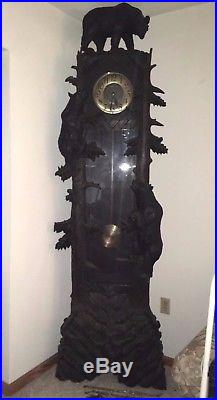

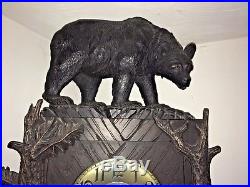



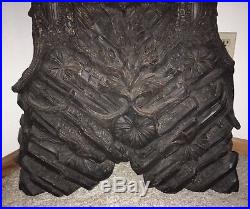

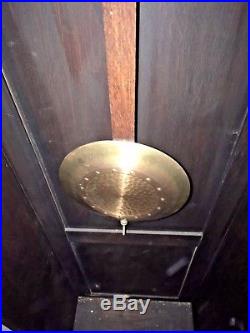

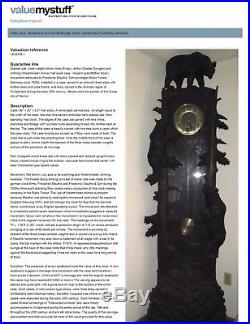


Antique Black Forest Carved Bears Floor Clock. W/ Kloster Gong Westminster Chimes.
This unique floor clock is from a family's estate antique collection. It has worked in the past but is currently not running. Stained oak, triple weight driven, time (8-day), strike (Kloster Gongen) and. Chiming (Westminster chime) hall clock (aka - modern grandfather clock).
Movement attributed to Friederick Mauthe, Schwenningen Black Forest. Germany circa 1920s, installed in a case carved in an arborial (tree) style with. Mother bear and cubs theme, and likely carved in the Brienze region of.Switzerland during the early 20th century. Bears were the symbol of the Swiss.
Case: 96" x 30" x 9.5 Hall clock. A removable carved bear, its length equal to. The width of the case, sits atop this carved rectilinear dark stained oak, floor.
The edges of the case are carved with tree limbs. Branches and foliage with two bear cubs ascending toward the mother bear at. The base of the case is heavily carved with two tree trunk, s upon which. The case boards are incised as if they were made of bark.
Clock dial is just under the standing bear while the middle third of the case is. Glazed to allow one to watch the descent of the three brass canister weights. And arc of the pendulum as it swings.
Dial: Unsigned round brass dial with black painted and stylized upright Arabic. Hours, closed minute ring to the outside, repousse hammered dial center with. Steel Continental type Spade hands. Movement: Not shown, but said to be a striking and Westminsster chiming. The Kloster Gong striking on a set of metal rods was made by the.
German clock firms, Friederick Mauthe and Friederick Mauthe & Son during the. 1920s when such standing floor clocks were a production of this clock making. Company in the Black Forest.The use of Westminster chimes is present. Because Mauthe was primarily making this movement (and clock) for export to. England following WW I and did not sign the clock for fear that the German. Name would scare away English speaking buyers.
To a replaced particle board seat-board which immediately suggests a replaced. If this is the original movement for this case. The markings on the movement. 60 would indicate a pendulum length of 116 cm and a pendulum.
Swinging at a rate of 60 beats per minute. The movement is powered by. Descent of the three brass canister weights and is wound via pull-up link chains. Claws, the ball marked with the letters,'F/M/S'.A repousse brass pendulum bob. Swings at the back of the case note that it has made very little markings. Against the backboard suggesting it has not been in this case for a long period. Condition: The presence of a new seatboard hurts the value of this clock. Seatboard suggesst a marriage of a movement with the case.
Such cases, in non-cuckoo type clocks, were most likely carved in. Switzerland (see historical notes), the latter I suspect was where most such. Cases were executed during the early 20th century. Called Brienz furnishings or "Edelweiss furniture" and were mostly. Accomplished in Switzerland during the entire period of the late 19th and. Throughout the 20th century and are still done today. The quality of the carvings.Are excellent and that accounts for most of the value provided for this piece. Black Forest carving became very popular in the mid-19th century, for the Victorian age embraced the art. For many years "Black Forest" carvings were thought to have been produced in the Bavarian Black Forest of Germany, but it has now been established beyond all doubt.
That they were the sole province of the Swiss. The wood carving industry of Switzerland originated in the picturesque town of Brienz. From humble beginnings of a. Carvers plying their trade in the community of Brienz. The carving industry was driven by the tourist industry; Brienz, Interlaken and Luzern and other such resorts were in vogue with the wealthy Victorians.
Bears were particularly popular, being the symbol for the city of Berne, but musical boxes, musical chalets, furniture large and small, all figured in Swiss carving. Variety was immense, ranging from the religious, faithful reproductions of Leonardo da Vinci's Last Supper to the amusing and the whimsical.
Far from being'mere whimsy' however, Swiss Black Forest carvings were exhibited at the London Great Exhibition of 1851, Chicago 1893, Paris 1900 and at many other. Of the great international exhibitions of the late 19th and early 20th century. Black Forest carvings stood alongside goods from the likes of Tiffany, Galle and Linke at such. Today there has been a tremendous revival of interest for them and the best pieces are highly sort after. Taken from the book "Swiss carvings 1820 - 1940" written by Jay Arenski, Simon Daniels and Michael Daniels. The item "Antique Black Forest Carved Bears Floor Clock Kloster Gong Westminster Chimes" is in sale since Monday, September 11, 2017. This item is in the category "Antiques\Decorative Arts\Clocks". The seller is "tumbleweed937" and is located in Miamisburg, Ohio. This item can't be shipped, the buyer must pick up the item.
- Age: 1900-1940
- Color: Dark Wood Tone
- Primary Material: Wood
- Country/Region of Origin: Germany
- Style: Black Forest
